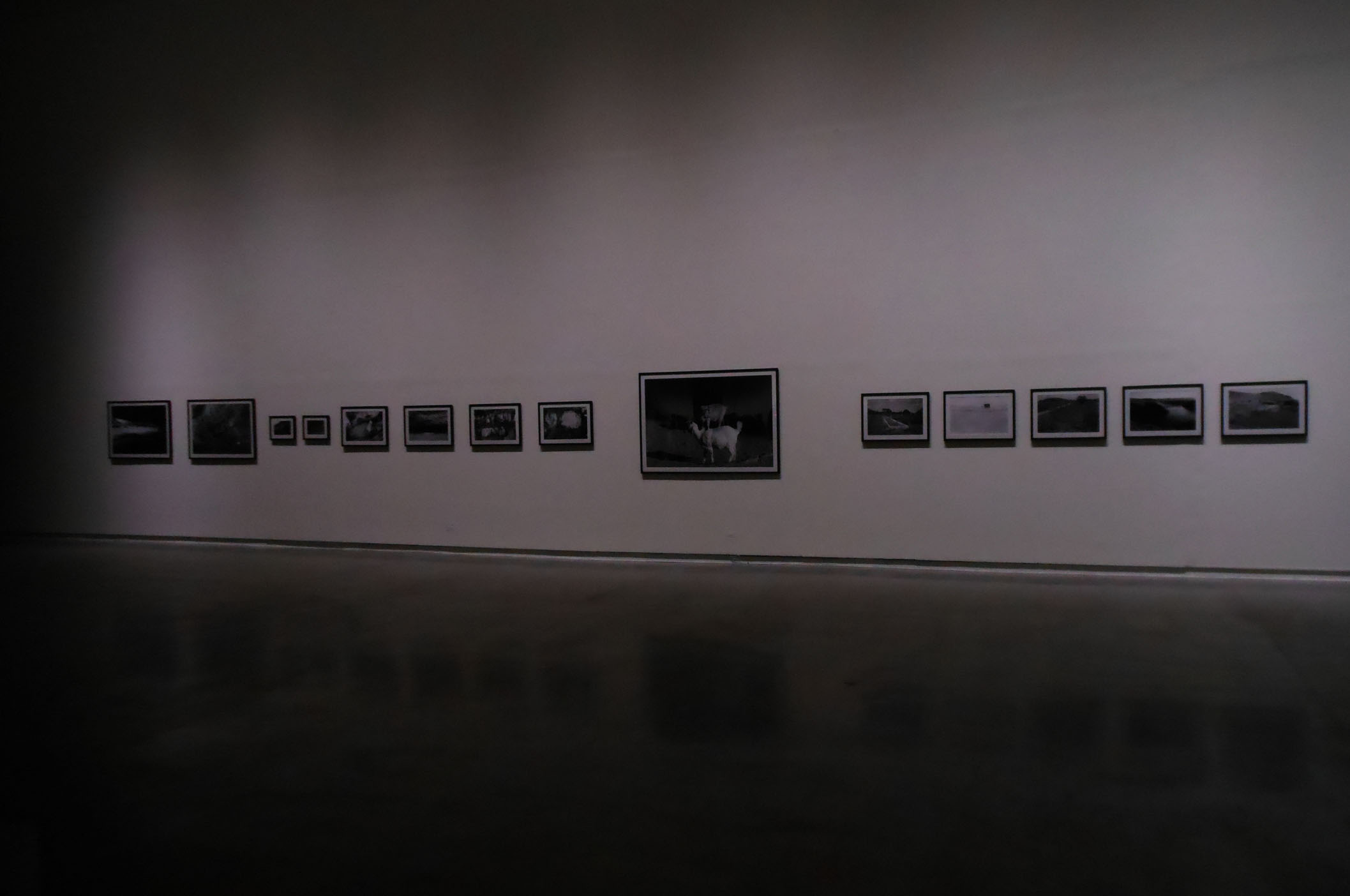形色之外:霍剛米蘭回顧展 - 采泥藝術
發佈日期:2018-05-23
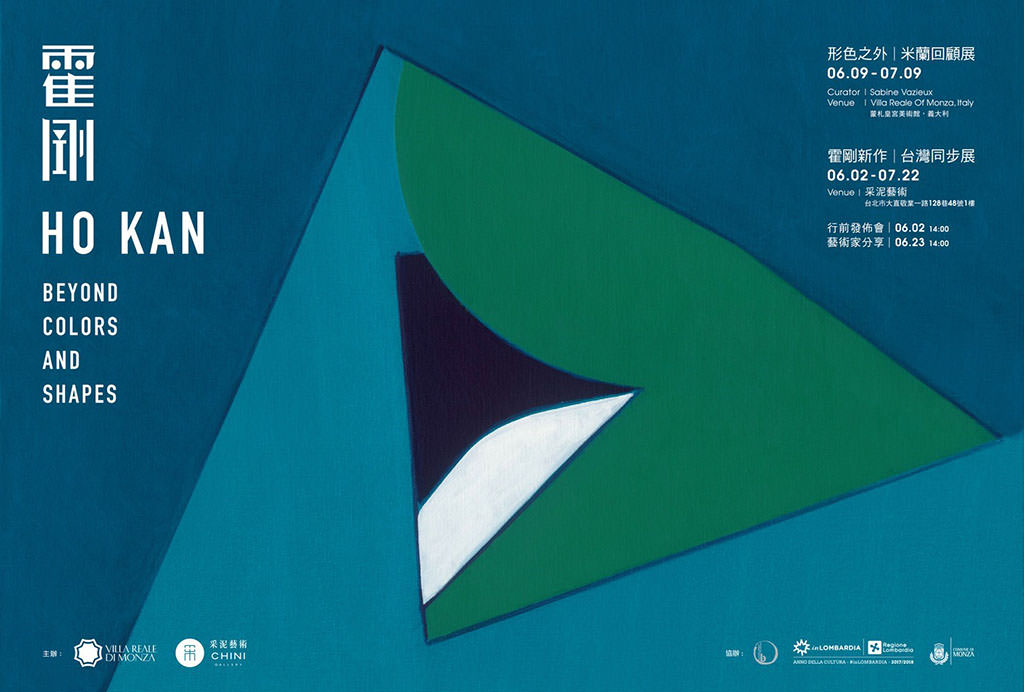
策展人談展覽
Beyond Colors and Shapes—From the Curator's Perspective
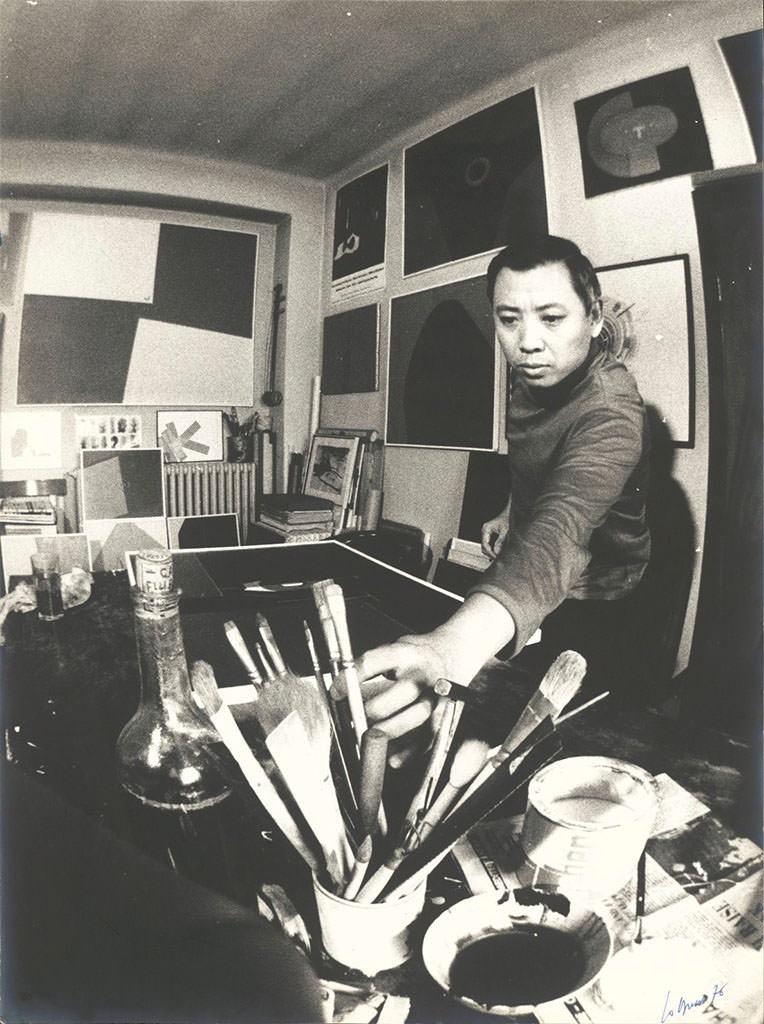
年輕霍剛在米蘭工作室創作
文/策展人:Sabine Vazieux
本展為Monza蒙札皇宮美術館特別為台灣抽象畫的先鋒藝術家霍剛所舉辦的大型回顧展,回顧藝術家自1950年代到2010年代將近60年的藝術創作。此次展覽將不僅展出霍剛最具有代表性的幾何抽象畫作,同時也將向大眾呈現1950年代藝術家在台灣創作的早期作品、近年的畫作以及與雕塑家楊北辰合作的雕塑作品。
1940年底,霍剛離開大陸,前往台灣。在台灣,他逐漸發現了西方藝術的魅力,並且熟悉了對當時亞洲尚屬陌生的油畫技法。這一系列的新發現讓在霍剛踏上現代主義的道路,仍保留其自身的文化根基。
在東西方的文化碰撞之下,霍剛用自己創造的獨一無二藝術,開展二十世紀華人繪畫的新局面。
The Villa Reale (royal palace) in Monza is holding a retrospective of the artist Ho Kan, who is considered one of the great pioneers of Chinese abstraction.The exhibition is presenting works produced during an artistic career that has spanned almost sixty years, from the 1950s to the 2010s. It highlights his most emblematic abstract geometric paintings, and also traces the evolution of his art by presenting—for the first time—the works he painted in Taiwan in the 1950s. Also presented are his recent paintings and several sculptures produced in collaboration with the sculptor Yang Bei-Chen.
A展廳
1950年代-1970年代:從台北到米蘭
霍剛1932年出生於南京的一個書香門第。在他父親不幸去世之後,霍剛搬去與時為著名書法家的祖父霍銳(或霍秋崖)同住。書法給予了霍剛許多藝術創作的啟示。幾年之後,他得以進入南京國民革命軍遺族學校。然而,實因時局的變化,霍剛遂在1949年離開大陸來到台灣,翌年進入台北師範學校藝術科學習。
然而,師範學校的課程過於偏向學院派,使得霍剛在1951年投入著名現代派畫家李仲生門下研習。李仲生注重因材施教,鼓勵每個學生尋找具有自我特色的創新風格。在當時,霍剛通過對西方藝術流派的探索豐富了他的藝術創作語言。他開始轉向超現實風格,在一張畫作中嘗試不同空間元素與主題的構成。1957年,霍剛與李仲生畫室的其他七位藝術家畫友共同創辦了東方畫會。直至1971年解散為止,東方畫會反對學院派畫風,在台灣現代藝術發展中發揮了至關重要的作用。
對於西方繪畫的興趣讓霍剛萌生了前往歐洲的念頭,他於1964年前往米蘭,並在此地旅居長達五十餘年。從這時起,霍剛轉向了幾何抽象,同時也保留了自身的亞洲文化。在他旅居米蘭的前期創作中,霍剛傾向使用一些陰鬱的藍綠色調,似乎是在回應他背井離鄉的的憂鬱情緒。
Room A
The 1950s–1970s: From Taipei to Milan
Ho Kan, who came from a family of scholars, was born in Nanjing in 1932. After his father’s premature death, he went to live with his grandfather Ho Rei, a renowned calligrapher who introduced him to art and taught him to paint. Several years later, he entered a military boarding school. Due to political events in China, he moved to Taiwan in 1949 and a year later he enrolled in the Department of Art of Taipei University of Education.
Finding the teaching too traditional, he joined Lee Chun-Shan’s famous studio in 1951, where he was encouraged by the master to develop his individual creativity. During this period, Ho Kan enriched his artistic vocabulary as he discovered new Western movements. He was attracted to the Surrealist style and was inspired to combine different spatial elements and subjects within the same picture. In 1956, Ho Kan joineded the Ton Fan Art Group, along with seven other artists and friends from Lee Chun-Shan’s studio. Breaking away from academicism, the group played a key role in the development of avant-garde art in Taiwan until it dissolved in 1971.
His fascination for Western painting led him to discover Europe and in 1964, he moved to Milan, where he lived for fifty years. He immediately focused on geometric abstraction, while maintaining his Asian cultural influences. During his first Milanese period, Ho Kan used dark blues and greens, echoing the melancholy he felt as a result of his recent exile.
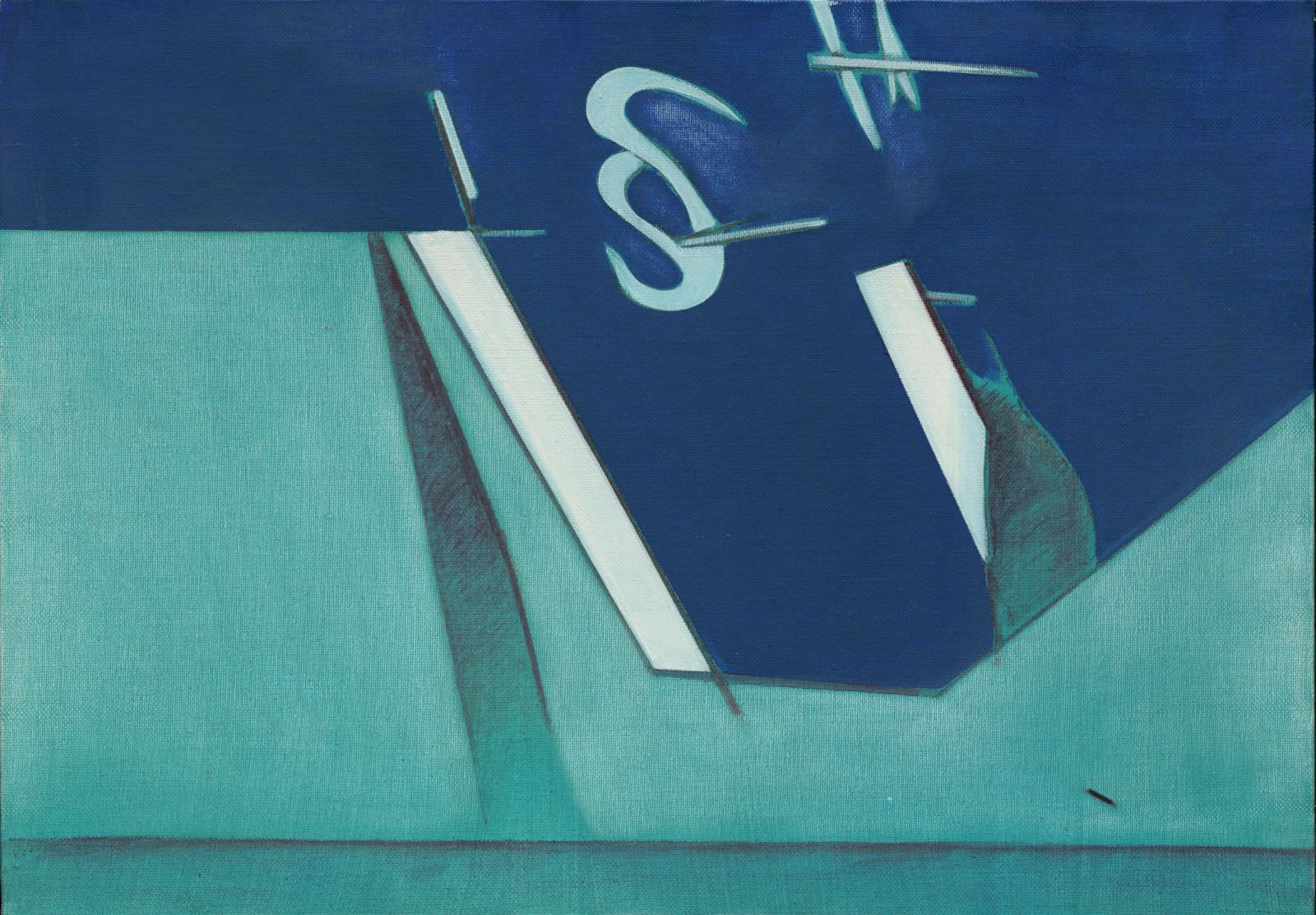
無題 Untitled
70x100cm Oil on canvas 1975
B展廳
1980年代-1990年代:書法之符號與形態
在這段時期,霍剛的繪畫色彩更趨多元,表現更為歡快。
初看之下,他的部分畫作非常接近西方的抽象藝術,但另一部分採用比較自由的風格。他喜歡運用一些小黑線,就如同被風吹起的漢字,散落在繪畫空間裡。這種以抽象詩意風格闡釋符號的新方式,讓霍剛拓展出了無限的想像領域。圓形,方形,三角形以及在這些形態裡流動的空間,都是藝術家從中國書法藝術中提煉而成的。
Room B
The1980s–90s: Calligraphic Signs and Forms
During this period Ho Kan used a broader and more exuberant palette of colors.
At first sight, some of his geometric works were closer to Western geometric abstract art, while others were more expressive. He painted small black lines, evoking disconnected Chinese characters that seem to float in the pictorial space, as though randomly blown by the wind. The fresh approach to the representation of signs, which was abstract and poetic, opened up an infinite imaginary repertoire. The circles, squares, triangles, and the space around these forms were all references to Chinese calligraphy, which he simplified, retaining only the structure.
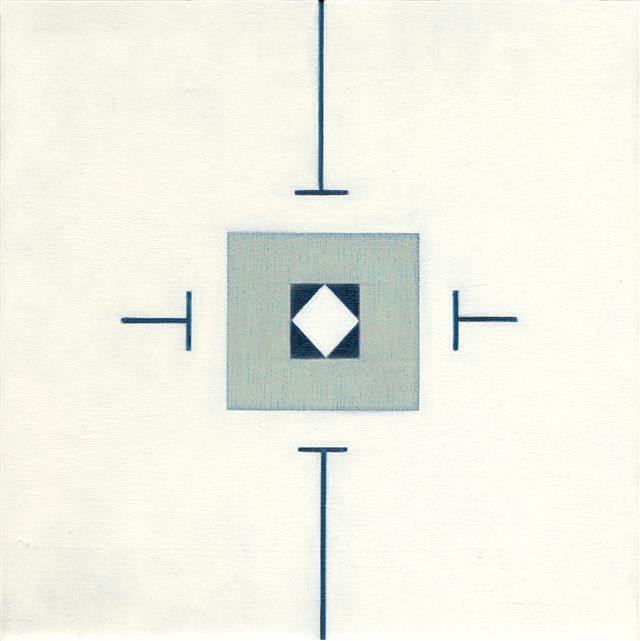
無題90 Untitled 90
60x60cm Oil on canvas 1990
C、D展廳
2000年代:完美的融合
霍剛在藝術創作的道路上更進一步,乃是將東西方文化的雙重性轉化為內在的真正融合。在此創作的巔峰階段,霍剛在形態與色彩之間實現了完美的和諧,他使用深色來中和「紅色」,「橙色」,「綠色」等色彩的亮度,完美地平衡了構圖。
在其《啟》和《開展》等系列創作中,畫作中小圓點的應用反映了「萬綠叢中一點紅」的中國美學理念。
Room C, D
The 2000s: A Perfect Fusion
Ho Kan developed his art and transformed Eastern and Western cultural duality into a veritable fusion between the two cultures. This was a period of mastery in which Ho Kan succeeded in creating a perfect harmony between forms and colors. He used dark colors to attenuate the luminosity of colors such as red, orange, and green, which gave the composition perfect equilibrium.
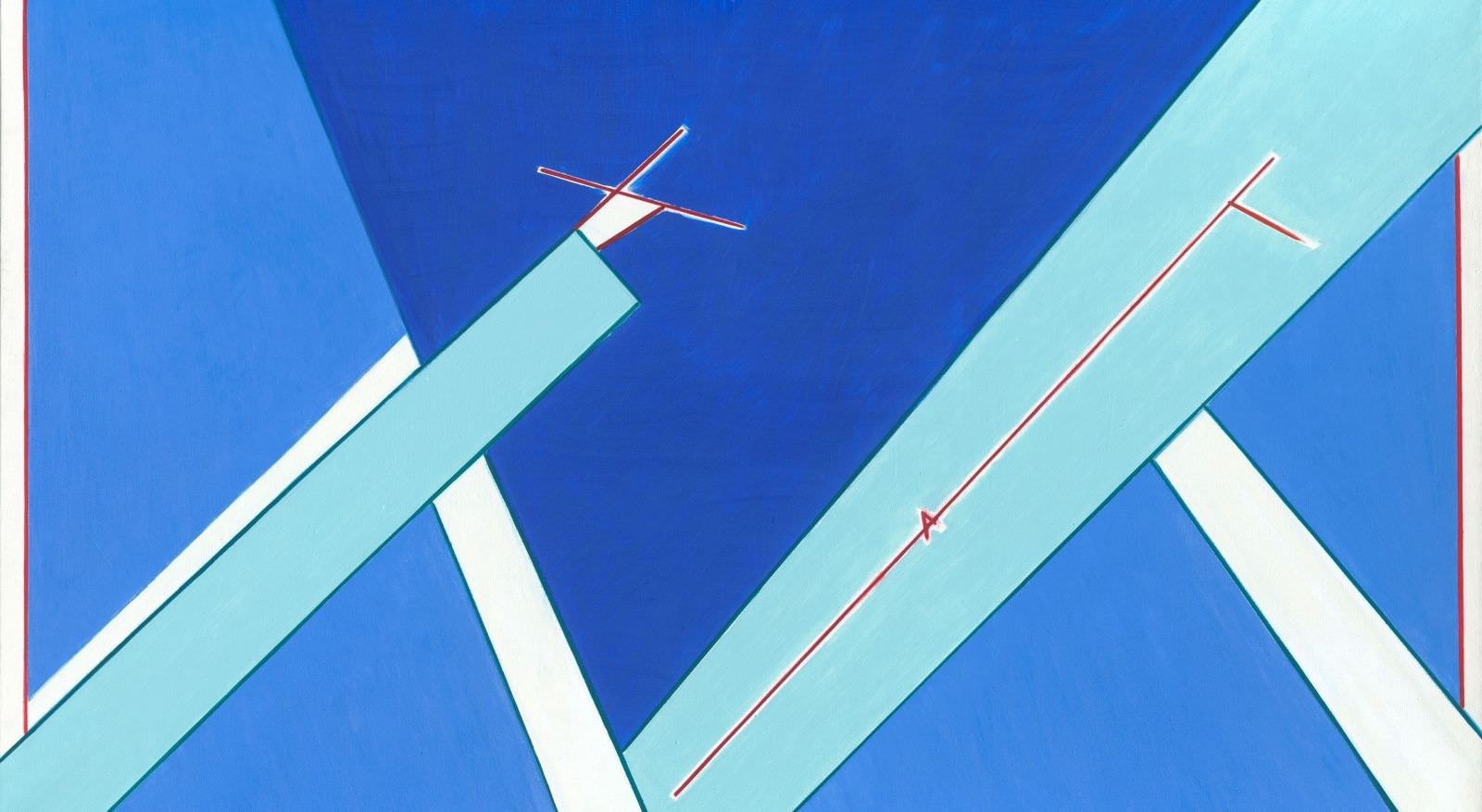
源起之21 Origin 21
111x193cm Oil on canvas 2006
E展廳
今日之霍剛:精神性
現在的霍剛創作到達了爐火純青的境界,他的藝術手法體現了深層的精神性。極簡構圖所表現的形態與色彩,與禪宗、道家等東方哲學思想相通,即運用最少的顏色和形式來闡釋極簡理念。
在他的創作中,霍剛創造一種抽象幾何風格,但從未走向純幾何的表現。他的線條揭示傳統書法藝術的活力與能量。
Room E
Ho Kan Today: A Quest for Spirituality
This mature period also highlights the omnipresent spirituality in his artistic approach. The simplification of forms and the restricted use of color in his compositions echo Chan Buddhism and Taoism, which both advocate simplicity via a minimal use of colors and forms.
Throughout his artistic career, he has developed an abstract geometric style but has never succumbed to a pure geometric style; underlying his lines are the calligraphic vivacity and energy of his cultural heritage.

抽象2015-066 Abstract 2015-066
50x60.5cm Oil on canvas 2015
F展廳
抽象之雙重性
這間展廳邀請我們去體察藝術家的想像世界與他所使用的符號象徵。想像力讓我們對霍剛畫作中的視覺元素進行一些可能的闡釋,如同中國漢字所引發的視覺感受。
我們觀察到一些具象的形象表現(如色彩斑斕的魚,如鳥等),但不要誤認為這只是偶然。這些巧合也正印證了道家「為無為」的思想,即以無為的態度去有所作為。
那麼,到底是抽象還是具象?對於藝術家霍剛來說,這並不是一個問題。對他來說最為重要的還是創作的樂趣。
Room F
The Ambivalence of Abstraction
In this room the viewer is invited to contemplate the artist’s dreamlike world and the symbols he uses. One is tempted to imagine possible interpretations of visual elements that seem to exist in his paintings, in the same way that Chinese characters sometimes evoke figurative visual forms.
Although it is possible to discern figures (a colorful fish or a bird, for example), they are quite incidental. They happen to be coincidences that might correspond with the Taoist philosophy of Wei Wuwei (meaning “accomplishing without doing”).
So, is his art abstract or figurative? Ho Kan does not see this as particularly important—what really matters to him is the sheer pleasure of painting.
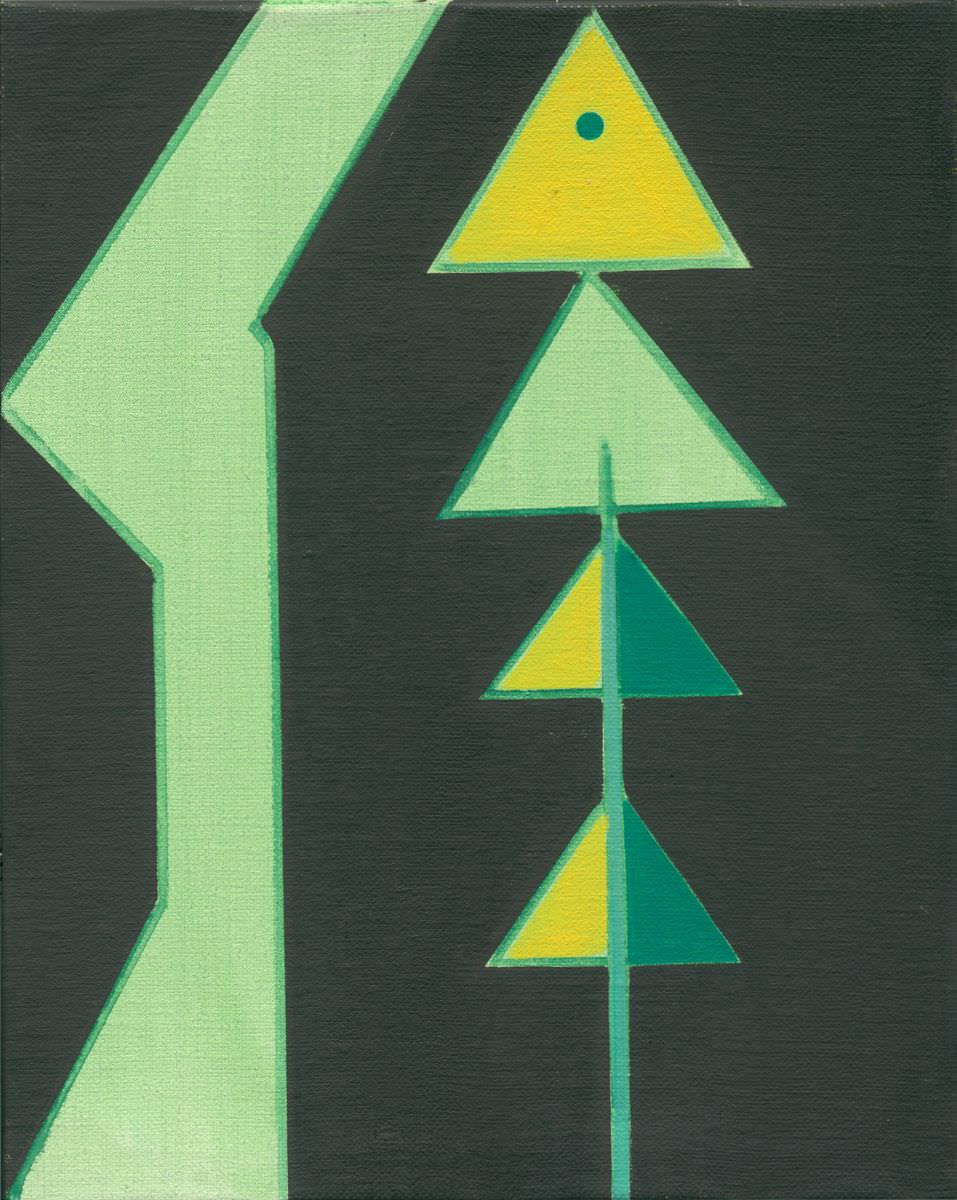
象形之2 Pictograph 2
50x40cm Oil on canvas 2007
展覽介紹
About the Exhibition
1964年,台灣東方畫會的先鋒藝術家—霍剛來到米蘭,開啟了長達五十年的旅義生涯。在這將近六個世紀以來,始終代表著歐洲繪畫頂峰的國度裡,霍剛吸取了義大利繪畫的傳統特色,亦受到當時藝術氛圍影響。在義大利生活期間,結識藝術家Luccio Fontana, Roberdo Crippa, Wifredo Lam, Mario Nigro......等人,畫作風格也逐漸明朗 ; 盡情發揮色彩的誘惑力,同時表現出對形體的追求,將兩者滲透至書道金石的氣韻流動中,奠定了自身的獨特繪畫風格且貫徹至今。不同於一般的冷抽象,霍剛的幾何更帶有東方的靈性思維與詩意。雖受硬邊藝術影響,他卻不採用厚塗的大面積色塊,而是運用不加雕琢的筆法,使畫面有如素描淡彩般地輕快、飄逸。雖然形象的感官功能性被抹去,畫中依舊不難見到各種生活的語彙與童趣感。
五十年代的霍剛深受超現實主義之神秘性及自動性吸引,當時在意象的變形上著墨較深。初來乍到歐洲後,雖逐漸遠離超現實主義,畫中仍舊帶有深沉的神秘色彩與形象,有如籠罩在沈鬱幽藍華貴的氛圍裡。七十年代之後,霍剛確認了幾何硬邊的風格,十分關注造形的遊戲以及繪畫空間的嚴謹安排,捨棄一切象徵, 與一切固有的規範,以找尋一種全新的美感準則。此時期的霍剛,較為偏向Malevitch的至上主義,幾何形象是色彩的載體,玩弄同一個色系的塊狀組合,到達的境界好似Malevitch「非物質將我引入一片幸福的『沙漠』,這裡別無一物,只有感覺。」。2000年後,其畫中色彩更趨鮮明愉快,對比統一而和諧。近十年的作品則更加靈動,藝術家無拘無束地讓潛意識揮灑,用色奔放自由,造形時而平穩輕快,時而迴旋反覆,更有不少具象呈現,融合其一甲子以來的兩大創作風格,成就了超現實感的幾何抽象。
承蒙米蘭近郊蒙札皇宮盛情邀請,今夏本展回顧霍剛旅居義大利五十餘年的創作歷程,更首次呈現耄耋之年益發精進的抽象畫家霍剛與寫實雕刻家楊北辰共同創作的雕塑作品,在抽象與具象/繪畫與雕塑間,塑造一個外於形色的心之空間/心象空間。
In 1964, Ho Kan, a pioneering artist in Taiwan’s Tongfang Art Group, came to Milan, where he would spend the next five decades of his life. In this country, which had represented the peak of European painting for nearly six centuries, Ho absorbed the characteristics of traditional Italian painting and was influenced by the artistic environment of the time. During his time in Italy, he became aquainted with Luccio Fontana, Roberdo Crippa, Wifredo Lam, Mario Nigro, etc., and his style also slowly became bright and open. Bringing the use of colors to its full play and demonstrating his pursuit of forms, the artist combined his colors and forms with the charm of calligraphy and seal carving, establishing his own unique painting style that he has continued until the present day. Unlike the cold abstraction commonly seen, Ho’s geometric expression conveys a sense of Oriental philosophy and poeticness. Although he has been influenced by the hard-edge movement, he steps away from using thick, large color blocks; instead, he uses unadorned brushwork to create his image with lightness and briskness that resemble light-colored sketches. Although his forms do not seem to possess any perceptive function, one can still detect a variety of vocabularies from daily life and a sense of playfulness in his painting.
Due to the heartfelt invitation by the Villa Reale of Minza in the suburb of Mila, this retrospective of Ho Kan showcases the artist’s works created within a span of more than fifty years. The exhibition also features for the first time sculptures created from a collaboration between this diligent abstract master, who is more than eighty years old, and the realist sculptor, Yang Pei-Chen. In between the abstract and the concrete as well as painting and sculpture, these collaborative works collectively materialize an inner/mental space that is beyond colors and forms.
「形色之外:霍剛米蘭回顧展」
日期:2018.06.09 — 2018.07.09
策展人:Sabine Vazieux
開幕:2018.06.09 11:30 am
地點:義大利蒙札皇宮美術館
「霍剛新作:台灣同步展」
日期:2018.06.02 — 2018.07.22
地點:采泥藝術
Opening 暨 行前發佈會:2018.06.02 14:00
藝術家回國分享會:2018.06.23 14:00
Beyond colors and shapes: A Retrospective of HO Kan
2018.06.09 — 2018.07.09
Curator: Sabine Vazieux
Opening: 2018.06.09 11:30 am
Venue:Villa Reale of Monza, Italy
------------------------------------------------
Beyond Colors and Shapes: A Synchronous Exhibition of HO Kan in Taiwan
2018.06.02 — 2018.07.22
Venue:Chini Gallery
Opening&Press Release:2018.06.02 14:00
Artist Talk:2018.06.23 14:00
(藝文報報新聞發佈)
